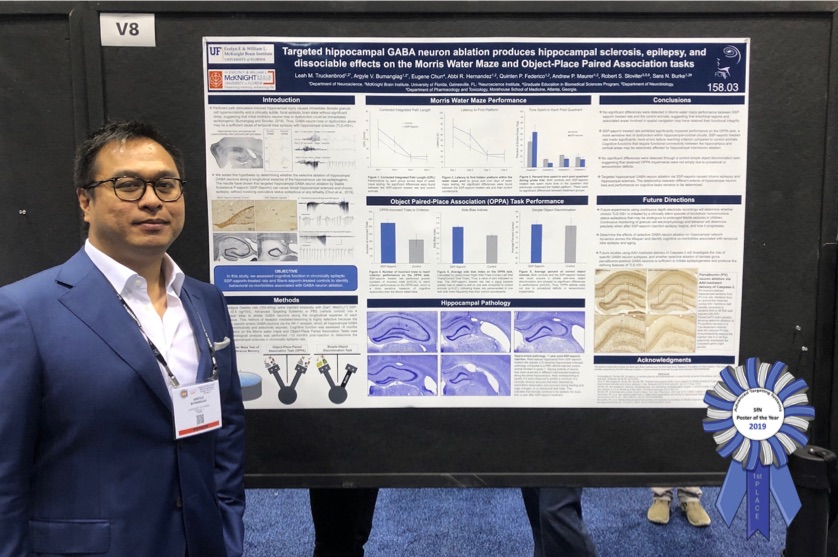Congratulations to Dr. Argyle Bumanglag and the team at University of Florida for the important work they presented using SSP-SAP to create an animal model of temporal lobe epilepsy.
Injections of SSP-SAP into the hippocampus of a rat causes acute hippocampal injury, permanent dentate granule cell-onset epilepsy, and hippocampal sclerosis that closely resembles the selective hippocampal pathology exhibited by patients diagnosed with TLE. The rats are chronically epileptic, with data going out a year for lesioned animals.
Be sure to check out the featured article in Targeting Trends.

An epileptogenic role for hippocampal GABAergic dysfunction has recently been reported (Chun et al., 2019). Specifically, selective ablation of hippocampal GABA neurons by Stable Substance P-saporin (SSP-saporin) conjugate caused dorsal hippocampal sclerosis and chronic epilepsy, without involving convulsive status epilepticus or widespread brain injury. The current study assessed cognitive function in chronically epileptic SSP-saporin-treated rats and their vehicle-injected controls ~8 months following injection. First, rats completed the Morris Water Maze test of spatial learning and memory (Morris et al., 1982). Animals then underwent testing with the object-place paired association (OPPA) task, which requires the hippocampus as well as functional connectivity between the hippocampus and cortical areas (Jo and Lee, 2010; Hernandez et al., 2017), and then a simple object discrimination task. Interestingly, both controls and rats with dorsal hippocampal sclerosis and chronic epilepsy were able to learn the location of the hidden platform in the Morris Water Maze task and could also acquire a simple pair-wise object discrimination. However, epileptic rats with dorsal hippocampal sclerosis were significantly impaired on the OPPA task, which requires animals to integrate spatial location memory with a correct object choice and is a more sensitive measure of cognitive dysfunction (Hernandez et al., 2015). These data indicate that, similar to humans with medial temporal lobe epilepsy, selective hippocampal sclerosis and epilepsy in this model do not result in global cognitive decline. Rather, cognitive functions that require functional connectivity between the hippocampus and cortical areas are selectively affected.
Also see the recent publication:
Chun E, Bumanglag AV, Burke SN, & Sloviter RS. Targeted hippocampal GABA neuron ablation by Stable Substance P–saporin causes hippocampal sclerosis and chronic epilepsy in rats. (2019). Epilepsia, 60 (5):e52-e57.
Objective: Hippocampal GABA neurons were targeted for selective elimination to determine whether a focal hippocampal GABAergic defect in an otherwise normal brain can initiate cryptogenic temporal lobe epilepsy with hippocampal sclerosis.
Summary: Hippocampal GABAergic dysfunction is epileptogenic and can produce the defining features of cryptogenic temporal lobe epilepsy.
Dose: Intrahippocampal injections of SSP-SAP (0.4 ng/10 nL) were performed using a 0.5-μL Neuros Syringe lowered into four hippocampal sites along both the transverse and longitudinal hippocampal axes bilaterally.
